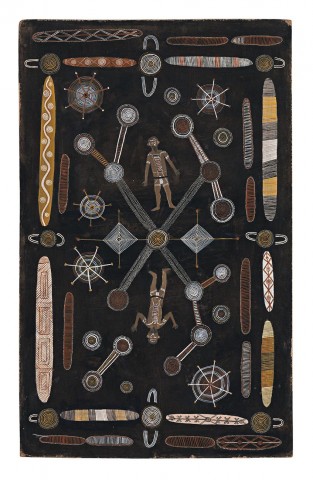MEN’S CEREMONY, 1972
ANATJARI TJAKAMARRA
synthetic polymer powder paint on composition board
97.0 x 60.5 cm
Painted in Papunya, Northern Territory
John Longley Snr, Melbourne, acquired in 1972
Thence by descent
Private collection, Melbourne
Men's Ceremony, 1971, synthetic polymer powder paint on composition board, 45.0 x 46.0 cm, formerly in the collection of Geoffrey Bardon, Papunya and The Laverty Collection, Sydney, illus. in Bardon, G., and Bardon, J., Papunya: A Place Made After the Story – The Beginnings of the Western Desert Painting Movement, The Miegunyah Press, Melbourne, 2004, painting 354, p. 398
Big Pintupi Ceremonial Occasion, 1972, 70.5 x 35.5 cm, formerly in the collection of Tony Norton and Jann Williams, illus. in Bardon, G., and Bardon, J., Papunya: A Place Made After the Story – The Beginnings of the Western Desert Painting Movement, The Miegunyah Press, Melbourne, 2004, painting 356, p. 394 (illus.)
Under the provisions of the Protection of Movable Cultural Heritage Act 1986, buyers may be required to obtain an export permit for certain categories of items in this sale. Information is available at http://arts.gov.au/movable or by contacting the Cultural Property Section: [email protected]. Attention is drawn to clauses pertaining to export in Section 3 of the D+H prospective buyers and sellers guide: www.deutscherandhackett.com/content/buying-and-selling
Described by Geoffrey Bardon as a man of wistful temperament, 'slightly built with a particularly calm and gentle manner … very attentive and interested in what was going on but saying nothing'1, Anatjari Tjakamarra was among the first of the Western Desert men to commence painting at Papunya in the Spring of 1971. Bardon recognised early that he was a painter of particular ability and by 1972, he had provided him with fine sable brushes that complemented his very fine line work. Anatjari occupied a particular place under the curved corrugated iron roof of the Nissen Hut that was the Men’s Painting Room. A place that ‘buzzed with excitement as men of high standing came together to paint a constellation of sites distributed across a broad band of country’2 and where Anatjari was able to observe the creative rush, individual styles and varied traditions that flourished in the early months of 1972.
Anatjari and his family were amongst the last of the desert dwellers to be moved off their lands by the ‘Pintupi Patrols’ and relocated to Papunya in mid-1966. These last arrivals became fringe dwellers, resistant to assimilation and consequently the least acculturated of the Papunya settlement, renowned for their uninterrupted deep cultural links and ritual authority. With the resurgence of interest in traditional culture which occurred in the late 1960s, the new Pintupi arrivals began to receive recognition as senior figures within the Papunya community. According to historian Dick Kimber, Anatjari was a ritually very correct, conservative man, with a great concern for country and the key influences on his work related to secret-sacred men’s activities.3
The current work, Men’s Ceremony, 1972, was most likely painted in May – June 1972, and illustrates a major men’s ceremony at an unidentified site in the artist’s homelands, far to the west of Papunya in the Gibson Desert, Western Australia. Painted on a matte black ground, a ceremonial site dominates the centre of the painting with space created in the composition by the careful separation of sites and related sacred objects, all of which are depicted in fine detail. The entire work is bordered by two rows of bullroarers and ceremonial objects of varying designs and importance, including some of a sacred nature which are wrapped in string for concealment. The painting has a reflected symmetry with elements mirrored either side of a centreline defined by two string crosses. This compositional characteristic and the inclusion of a pair of painted ceremonial figures highlights the influence of Anmatyerre artist, Kaapa Tjampitjinpa. Despite coming from different cultural backgrounds, Anatjari’s art was heavily influenced by Kaapa and as John Kean noted, ‘Anatjari adopted Kaapa’s sparse background and shared his capacity for graphic precision, punctilious attention to detail and both artists express a similar meticulous sensibility’.4 From the variety of designs found depicted on the objects in this painting, it is possible that multiple stories are being recorded, but the final result is a work that re-traces and re-affirms the artist’s relationship with the land, its people and their mythologies.
1. Bardon, G., and Bardon, J., Papunya, A Place made after the Story, The Miegunyah Press, Victoria, 2009, p. 71
2. Kean J., ‘Framing Papunya Painting: Form, Style and Representation, 1971-72’ in Scholes L. (ed.), Tjungunutja: From Having Come Together, Museum and Art Gallery of Northern Territory, Darwin, 2017, p.192
3. Johnson, V., Lives of the Papunya Tula Artists, Alice Springs, IAD Press, 2008, p. 7
4. Kean, J., in Scholes, L. (ed.), op. cit., p. 179
CRISPIN GUTTERIDGE
